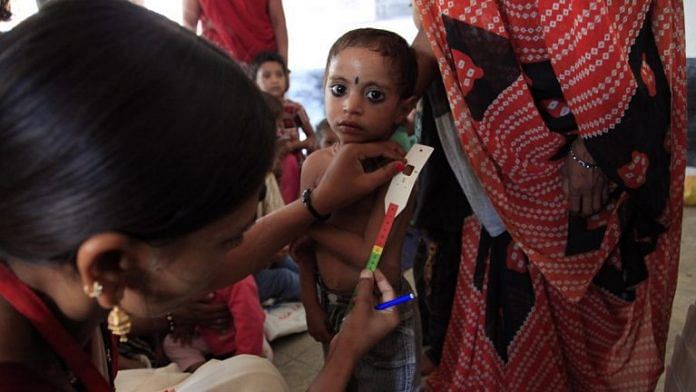Reducing the burden of child undernutrition has been central to the developmental goals of the Government of India. The flagship programme, POSHAN Abhiyaan, launched in 2018, provided a much-needed fillip to the nutrition agenda. Dedicated budgetary allocation, and administrative and community efforts are expected to accelerate nutritional improvements in the years to come. Until now, the latest available estimates on various measures of children’s nutritional status came from the fourth round of the National Family Health Survey, or the NFHS, conducted in 2015-16. The much-awaited statistics on the prevalence of nutritional status among children from the fifth round of the NFHS conducted in 2019 in 17 states and five Union Territories (UTs) is out.
What can we learn with regards to the progress the country is making in terms of reducing the burden of undernutrition among Indian children?
Stunting prevalence
Considering the commonly used measure of anthropometric failure as an indication of undernutrition, it is clear that there cannot be any let up to the efforts that have been put in place recently. On all three measures of anthropometric failure (stunting, underweight and wasting) the mean prevalence across these 22 states/UTs has increased (see table).

Stunting prevalence decreased in nine states/UTs and increased in 13 states/UTs. Greatest reduction occurred in Sikkim, Manipur and Bihar. However, stunting increased in Kerala, Goa and Himachal Pradesh, i.e., states typically seen as ‘better performing’. It also increased in Maharashtra, Gujarat, and West Bengal. The prevalence of underweight, meanwhile, shows reduction in six states/UTs whereas wasting reduced in only eight states/UTs.
The POSHAN Abhiyaan had set a target of achieving two percentage points per annum reduction in stunting and underweight prevalence. None of the 22 states/UTs were able to achieve these aspirational targets in stunting or underweight, with Tripura and Nagaland showing an increase of more than two percentage points per annum. It is concerning that in seven states/UTs, all the three indicators have worsened since NFHS 2015-16. These include Himachal Pradesh, Kerala, Lakshadweep, Mizoram, Nagaland, Telangana and Tripura. Only three states i.e., Andhra Pradesh, Karnataka and Sikkim showed improvements in these three anthropometric indicators.
The decline in stunting by 5.4 per cent for Bihar is a bright spot in what appears to be a disconcerting trend. We hope there are opportunities to learn from this decline that can then be useful for other states, and to ensure that Bihar sustains this trajectory of decline. Notwithstanding this welcome trend, Bihar remains the state with the highest prevalence for stunting and underweight.
With the economy shrinking in the first two quarters of FY21, the Union and the state governments will also find themselves constrained in enhancing developmental spending directly related to nutritional health and well-being. But it is important that flagship schemes of the government of India display the same commitment as before, pandemic or not. In fact, these areas need an ever-greater intent and purpose in supporting states/UTs in their mission to reduce the burden of undernutrition among children.
Also read: India needs to ensure mothers’ higher education to eradicate child malnutrition, study says
What needs to be done?
It should be noted that ‘averages’ in India – even at the state level – mask more than they reveal, whether it relates to the geographic differences within a state (e.g., districts) or the differences in the prevalence across socio-economic groups. It is well known that the most crucial determinant of a child’s anthropometric status is the household socio-economic well-being. It is crucial that the POSHAN Abhiyaan should find means to enhance and optimise resource allocations with a targeted focus on the poor and deprived sections. In addition to the programmes that are directly related to nutrition (e.g., food), the time is ripe to link sector- specific initiatives with the broader goal of poverty alleviation and improving the overall standard of living through employment generation and asset creation. Since the burden of anthropometric failure is known to be a consequence of multiple factors, the response to reducing it needs to embrace this perspective by convergence across sectors.
It should be noted that the sobering statistics delivered by the latest NFHS predates the Covid- 19 pandemic and the subsequent 2020 lockdown that followed as a response. Thus, the data that got released for 22 states/UTs, especially for those that appeared to have experienced a decline, needs to be interpreted cautiously as situation may have worsened. Similarly, states that experienced an increase, the magnitude could be even greater.
The NFHS 2019-20 is currently underway in the remaining 14 states/UTs, and we may be able to use this creatively to assess the impact of the 2020 lockdown that has relegated the economy and brought widespread disruptions, impacting the lower socio-economic groups disproportionately. For the first time since NFHS started measuring nutritional status systematically, India finds itself at an elevated risk of experiencing a trend-reversal in the prevalence of stunting and underweight. It may seem that child undernutrition — at least as measured through anthropometry — is turning out to be the Achilles’ heel of India.
Acknowledgment: We thank Abhishek Kumar for his timely research assistance. Abhishek is a doctoral candidate at Central University of Gujarat.
William Joe is Assistant Professor, Institute of Economic Growth, New Delhi, India. S. V. Subramanian is Professor of Population Health and Geography, Harvard Center for Population and Development Studies, Cambridge, MA, USA. Views are personal.



